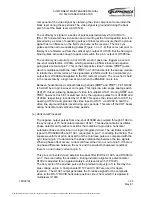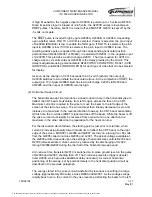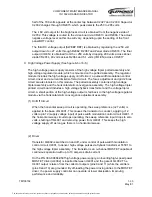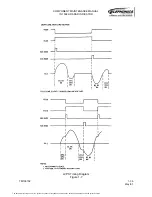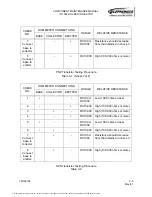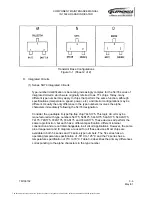
COMPONENT MAINTENANCE MANUAL
IN 1502H RADAR INDICATOR
TM109102
1-31
May/01
When Q4002 is off, the fi28 volt input is applied across the MOSFET. When
Q4002 conducts, the voltage is applied across the primary of T4501. The amount of
time Q4002 is allowed to conduct is controlled by the output from U4001. The longer
Q4002 conducts, the more current is applied across the primary of T4501. At 50
percent duty cycle, the pulses are approximately 6 amps in amplitude.
Resistor R4016 senses current and activates a current limiter if current becomes
excessive. The current limiter is discussed later.
(3) Pulse-Width Modulation Control Circuit
Integrated circuit U4001 includes a precision 5-volt regulator, error amplifier,
adjustable oscillator, dead-time control comparator and two output transistors. (Refer
to integrated circuit diagram in section III of of the RDR-1500B System Manual
(IB21500B), Volume One TM109302 (006-15589-0000).
The error amplifier senses a small portion of the high-voltage output from the tripler
assembly, fed back to pin I (EA+), which is the noninverting input of the error amplifier.
The inverting input (EA-,) at pin 2 is connected to the high voltage adjustment
potentiometer, R4012, which picks off a portion (3.2 to 4.3 volts) of the precision 5-volt
reference. This potentiometer is factory adjusted to provide 21 kV to the CRT high
voltage anode.
The frequency of the output (pins 9 and 10) to driver Q4002 is adjusted to 15.625 kHz
by potentiometer R4015 and synchronized by the XRET input signal at pin 6 of
U4001.
(4) Current Limiter/Soft Start Circuit
Soft start and current limiting are both accomplished by controlling the dead time input
(pin 4) of the pulse width modulation control circuit (U4001). Maximum duty cycle is
obtained when the dead time input is grounded (zero volts). A positive voltage applied
to the dead time input reduces the duty cycle. At about +3 volts, the duty cycle
decreases to zero percent (no output).
Soft start is provided by the combination of R4013 and C4013. The junction of those
two components is connected to the dead time (DT) control input of U4001. Thus,
when power comes on, the +5 volt reference output of U4001 is applied immediately
to the dead time control, keeping the pulse width modulation control circuit off. As
C4013 charges through R4013 the dead time input decreases until C4013 is fully
charged.
Current limiting is provided by transistors Q4003 and Q4004. Those two transistors
operate to increase dead time, thus reducing the duty cycle of U4001, in the event
that current through the driver (Q4002) becomes excessive.
Current is sensed at the junction of R4016 and R4023. The voltage at that point is
normally about 0.6 volts when Q4002 is conducting. Part of this voltage is dropped
across R4023 and therefore is applied to the base of Q4004. If current becomes
The document reference is online, please check the correspondence between the online documentation and the printed version.









